Napier
mechanic Bertram Ogilvie
saw the Wright plane
in 1907 and decided he could improve on their
warp control
to bank aircraft by using
automatically-controlled ailerons. |
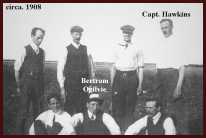 |
|

Arthur
Pickard Hawkins |
A
model was constructed. Arthur Pickard Hawkins,
one of Mr.Ogilvie's employers at Hawkins &
Rome, and late of the
11th Hussars, arranged a syndicate to finance the
project,
(the Hussars later formed the Royal Flying
School). |
|
Patent rights costing £800 were
obtained in the principle countries of the world in 1909.
With several enthusiastic workers, construction of the
first bi-plane began. |
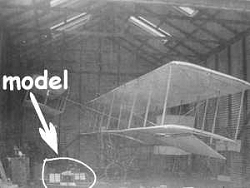 |
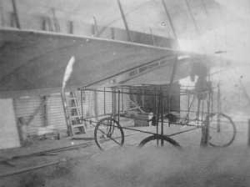 |
| Work
was carried out in a hangar along Riverbend Road,
Napier.... |
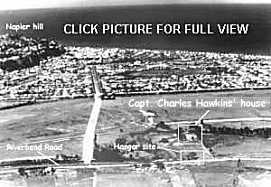 |
....where
a 30-metre long x 6-metre high ramp was later
built
to aid the machine's lift-off. |
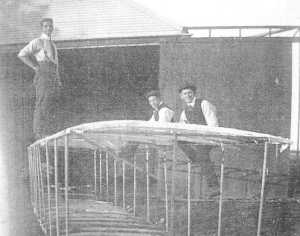 |
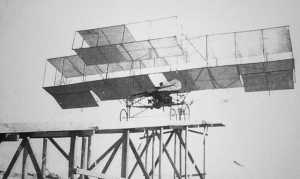 |
|
Three machines were built in all,
none of which flew as the engine was not powerful enough.
The first bi-plane was built of white pine, (kahiketea),
with broomsticks for struts,
yacht rigging screws as turnbuckles and piano hinges for
ailerons or flaps. |
 |
A
10-horsepower, two cylinder V-twin engine
with a 2.45-metre diameter hickory propellar
was built. However, the engine was not
powerful enough to turn it, so the propellar
was whittled down until it could.
An adjustable pitch prop of steel tube and
aluminium blades was constructed
and functioned fairly well. |
|
|
In March 1910, Mr. Ogilvie's
experiments attracted the attention of Field
Marshal Lord Kitchener,
who was visiting New Zealand. He encouraged Mr. Ogilvie
and Hawkins to conduct further trials in England. |
 |
En-route,
Mr.Ogilvie designed a tri-plane and had it
built by aircraft constructors Handley Page.
The Hawkins-Ogilvie machine with ailerons
connected
by an automatic balancing device, had a 7.6-metre
span and a four cylinder 50hp water-cooled
Alvaston engine. After initial problems with the
engine, (eventually replaced by the makers),
the plane proved to be a speedy flier and the
patented automatic balancing apparatus a success. |
|
| The aircraft reached heights of 61
metres during trials in the Winchester area. Shortly
after making a crash-landing through running out of
petrol,
(breaking only a few struts and a skid), the plane was
moved to Brooklands.
Colonel
Capper of Farnborough, (Commandant of
the Balloon School U.K. from 1903 to his retirement
in 1910),became interested in the machine, offering to
build a hangar at Shorncliffe.
The machine was entered in a race to cross the English
channel,
(Those Magnificent Men In Their
Flying Machines ???),
which had a £4000 prize but the syndicate ran out of
finance and was
forced to sell the machine and return to Napier.
|
THE
ROMANCE OF AVIATION IN NAPIER
The text on the right has been retyped
from a very rough original
(but still word for word). It seems to
have been written up many years ago
by someone who wished the information to
be recorded for posterity,
and was among Arnold Wright’s photo
collection on aviation. |

(click
to read) |
It
provides an explanation to photos in a
little album covering Bertram
Ogilvie’s
(early 1907 on) aircraft experiments at
the Riverbend Road site.It appears
Arnold may have loaned or given the album
to another party
as it was presented to the Hawke’s
Bay museum some years ago.
The photos appear to be from one of
Arnold’s early cameras (possibly his
fathers?) as there
are other photos in Arnold’s
collection of the same size and the same
era, in similar albums.
Without the
text to the photos in the album it left
the Ogilvie “story” incomplete
Now they are both together again we have
fascinating historical record of a very
talented man,
one could say. It would be great to
“come across” some of his
designs one day.
|
|
|
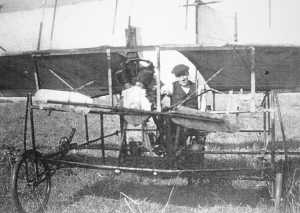
Bertram Ogilvie in one of
the
3 "machines" built |
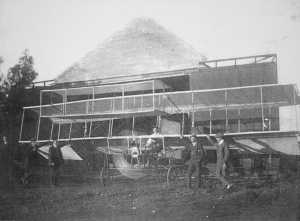
Bert, (as his friends
called him),
doing an engine test 'run up'. |
|
| |
Titled
"A Mishap". Bert in the waistcoat.
The lady? Possibly a Miss
Chadwick. |
 |
|
Mr. Ogilvie remained interested in
aviation, keeping in close contact with the
Napier Aero Club. He built a model of a direct-lift
machine around 1936.
He died in 1944. |
|
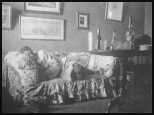 |
"The
Morning After" the mishap...
...and they must have had many
hearbreaking disappointments. |
| |
|
 |
Some
of the team enjoying what they call
"refreshments" |
 |
The
Riverbend Road hangar |
|
|
We assume this
photo of a group on board one of The Napier Ports
‘Lighters’
could be possibly Ogilvie and Hawkins on their
departure to England,
as it was among the photos covering the Aircraft
experiments at Riverbend Road.
We had thought it may have been Lord Kitchener
arriving or departing. |
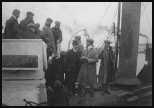 |
|
Bert’s
Grandaughter has been doing some research and discovered
Kitchener arrived and departed Napier by car.
We can not ID’ any of the group, as they could be
well wishers to see them on there way or other passengers
being shuttled out to the larger o’seas ships that
used to lay out in the harbour,
due to the lack of depth at the Napier port to
accommodate them at that time. |
|
 |
This
could be the UK hangar at 'Pitt Down' near
Winchester
or 'Pitton' near Salisbury. Perhaps someone from
the UK may be|
able to contact
us with some info??
Our records state Pitt as the
test-flight area for the Handley-Page triplane.
The negative for this photo is over 94 years old
and, it seems, a different type from all the
others. |
|
|
The
2nd flying-machine built by Bertram Ogilvie...
perched on top of the 100-foot launching pad
which he built
to test it. Photo taken in 1909 at his Riverbend
Road property. |
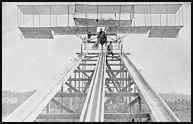 |
|
|
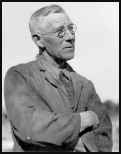 |
A
little postscript to the Ogilvie story...
Ogilvie, Hawkins and the
support team faced continual setbacks in Napier.
It must have been very, very frustrating for
them. Without an engine with sufficient power to
test-fly their incorporated aileron design, and
having to build three aircraft, we have to admire
their dedicated persistance.
|
|
Again,
later, with the disasterous financial losses
through having to sell the Handley Page triplane,
(UK 1911/12), Bertram and Arthur's return to
Napier must have been a very sad occasion. The
triplane did incorporate the aileron design and
did fly satisfactorily on test flights. It must
have been devastating, too, for all those
involved back in Napier, including the syndicate
who had backed the patents and the trip to the
UK.
All they needed were funds
to modify an aircraft which did perform
reasonably well.
Having to abandon this project simply because of
this...painful.
It is interesting to note
that Colonel Capper became so enthusiastic about
the triplane, he offered to build a hangar for
it, and to provide help in the aircraft's
development.
When the funds finally ran
out for the Ogilvie-Hawkins project, the aircarft
was purchased by...someone...and trailered off to
Brooklands airfield - where we lose track of it.
What happened to it at
Brooklands? Were the required modifications
carried out? Did it fly again?
It was booked to fly the English Channel. Did it?
It's all a bit of a mystery which is worth a
follow-up.
We do hope someone in th UK can take up this
task.
Colonel Capper - to quote
from a UK gliding magazine - was a "proper,
British army officer" of the East India Coy,
in charge of developing balloons for artillery
observation prior to WW1. Back then, he harboured
a secret vision of manned-flight and hired
American aviator, Samual J. Cody, to help him.
Ogilvie and Hawkins were among some pretty 'with
it' people for the times.
|
|
| |
|
| |

